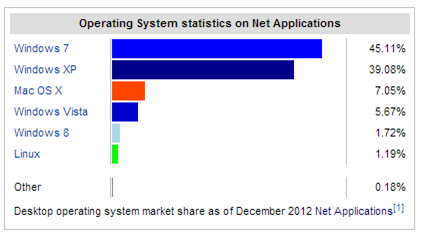Macromedia and Adobe revolutionize the interactive web space by providing Flash player based technologies. We see Flash player installed in 99% of desktops and gradually making its mark in unconventional platforms like Mobile & Smart TVs.
In 2005 with release of Flex SDK and later Adobe AIR the Runtime Environment made a huge impact on how information can be expressed on internet and desktop application. Adobe AIR is available on all popular desktop platforms i.e. Mac, Windows and Linux.However in a strategic move Adobe decided to discontinue further release of Adobe AIR on Linux. This fumed a lot of discussion and added a dent on Flex & AIR path of success. Though this is a year old story and Google can give at least a million links of this discussion.
Then why I am digging it again? because in spite of all the negativity spread around and future of AIR is written off by many Gurus, nothing happened of such kind. AIR is progressing manifolds and I clearly envision it, why Adobe has taken such step. I can see the reason why it has not affected even a slight interest in this beautiful technology and is making its success mark with many successful apps.
"As the market shifts to mobile devices, Adobe is investing in bringing its runtime technologies to new hardware and operating systems. Adobe is increasingly investing in mobile authoring. The recent Creative Suite 5.5 release is focused on enabling customers to deliver their experiences across devices using Adobe's technologies. Adobe has responded to the changing market trends by providing AIR support for a growing number of platforms. These platforms include Android, iOS and BlackBerry Tablet OS, televisions, and set-top boxes. Lifetime AIR for Linux desktop downloads represent less than 0.5% of total AIR desktop downloads, which number over 450 million. Therefore, Adobe has decided to change the distribution model for Linux and direct these resources toward its mobile efforts. Adobe's efforts are focused on supporting operating systems that are most important to its customers, and that demonstrate the greatest opportunity for future growth for its partners and developers. Adobe continues to provide partners the opportunity to license source code through the Open Screen Project. You can download AIR 2.6, the last version to support Linux, at the archive build page." source: here
There are lot to be said, but I will limit my discussion on the top most which clarifies the right move of Adobe.
1. Linux penetration on Desktops:
So before looking into how feasible AIR is on Linux, I questioned myself how feasible Linux itself is in terms of desktop OS. The result were not very surprising and very inline to our facts,

The image shows the total penetration of Linux as a desktop OS taken on Dec 2012. It clearly shows that this more than 2 decade old strong OS is not even crossing the total number of Windows 8 installations which released recently.
Had if we trying to solve a physics formulae, we could have easily considered it negligible, so did Adobe ;-)
Linux is a strong server side OS and have no doubt about its power, however it is not meant for Desktops and thus targeting a technology for that is not feasible in comparison to other progressing platforms. Thus moving an interest from a not so popular platform to increasing platform like Android is much productive.
2. Adobe donated Flex to Apache:

As we all know Adobe donated Flex to Apache and have no direct control on its development. Since incubation Apache Flex has released two builds and has recently been promoted to a mainstream project. Which says, Apache Flex has a clear future like any other projects running under Apache umbrella. The future SDK releases of Flex will be community driven. Adobe is in process of donating all of the source code related with Flex & associates projects.
Now how it affects AIR ? very much ! AIR is a technology which is written around Flex SDK and if Flex goes in a community driven path, it makes truly sense that Apache AIR to follow the same line. Otherwise why would a community put their efforts to run a proprietary technology. With immense increase of new platforms every day, only that technology will survive which is coping up with demand of community, and AIR suits the requirement but it also needs to take the same pace. Thus there is a need of community interference. Adobe is committed to keep on developing for new platforms in future, however even for Linux it invites partners through Open Screen Project (OSP) Partners program. For now AIR is graduating as a true cross platform Mobile development platform with its unique native compilation features.
3. Future of AIR as a cross-platform application development:
AIR started as a cross platform desktop runtime solution but gradually it took over on mobile big time. With release of Flash Builder 4.5, AIR projects can be deployed across iOS, Android and Blackberry. In most of the cases it can be achieved with the same code base and different manifest files.
Ability of writing native extensions for different platforms enhanced the chances of writing code which is not available in AIR as well.
The power of AIR is also with its multiple technology support, so far we were talking about Flex/ActionScript based development, but AIR also support HTML & JavaScript, thus writing a code with JavaScript and running into AIR is very much possible. This opens a whole new paradigm of writing web pages and embedding it inside an AIR application.
Smart TV, an another powerful platform recently allowed Adobe AIR runtime preinstalled in their firmware. Samsun App market and Google Play market already started accepting AIR based applications for Smart TV. This is unexplored market where AIR because of its extensive UI capabilities and strong backend integration, can be the best chosen option.
Coming back to our topic, it is evident that though Adobe is not directly working on Linux as a desktop, but it is very much working on different micro flavors of Linux. Truly, if I see the future of Linux as an OS for consumers, I see it in various embedded devices and unconventional platforms. It is clear that AIR is very much available on them and will continue its support.
Conclusion:
- Adobe intention of not continuing AIR for Linux was not to discourage the development but to extend support for fruitful platform.
- AIR for Linux can still be delivered through partners or from Open Source Community
- AIR is the front runner of all Cross Platform Mobile Application Development technologies because of its extensive reach on devices and huge eco system.
It is clear that AIR non availability on Linux desktop is not that big pain point, it is a wise move of discontinuing it and put the same effort to make other appropriate platform supported.
Links worth looking for more info:
- AIR for linux download
- Adobe AIR and linux
I wish all the success to Adobe AIR and would love to work over it in future.
Happy FLEXing. :-)
So, what is your view? Please share your thoughts with us. And don't forget to share this article if you liked it. You should also get connected with us on Twitter and “Like” vEmployee's Facebook page to receive updates on latest happenings around User Experience Space.








